Australia's best producers you need to know this Christmas
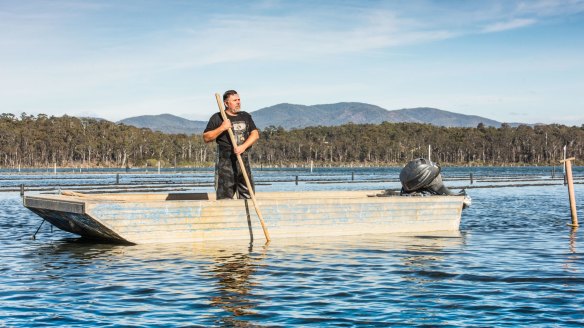
Behind every great mouthful of food you enjoy this festive season is a farmer, a fisher or a grower who has been working tirelessly throughout the year. Despite exceptionally testing times, these heroes have continued to grow some exceptional food.
This year we travelled thousands of kilometres across the country to meet the producers who we think are among the very best in the land. They told us their stories and brought us into their world, showing us how they make some of the finest food that will be gracing tables across the nation this Christmas Day.
Oysters
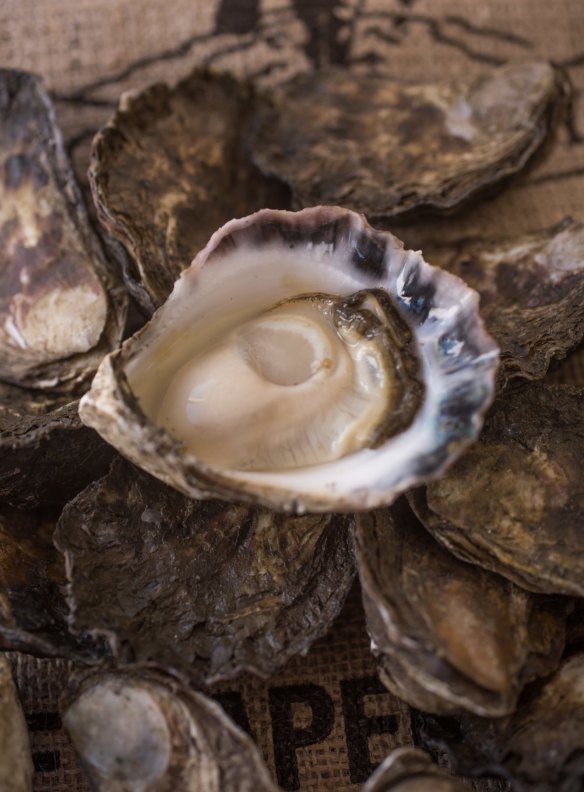
Shane Buckley slides a knife under the shell of one of his Sydney rock oysters. Plump and creamy yellow, it fills the deeply cupped shell. It has the briny tang of the sea and the estuary in which it was raised. It is no wonder that Buckley's Wapengo Rocks Wild Organic Oysters are on the menus of the best restaurants in Sydney and Melbourne. He takes a lot of time to get them tasting so good.
It started 12 years ago when Buckley took over an oyster lease at Wapengo Lake, on New South Wales' South Coast. He was an intensive care paramedic and wanted a quieter life. "But I didn't want to grow oysters, sell them to a processor and end up with a nameless product on a plate," he says. "I wanted people to know where they came from."
Wapengo Lake is stunning. It is fed by a river whose headwaters are in the forest-cloaked slopes of Mumballa, a mountain important to the Yuin Indigenous people and now in a national park. The waters are crystal clear, helped by the local council, which sealed the gravel roads around the lake, with a little urging from Buckley, stopping murky runoff.
Buckley removed the treated pine posts that held the racks and the tar-coated sticks on which the juvenile oysters were caught. He replaced the old infrastructure with floating bags that tumble and turn on the changing tide, helping the oysters develop their adductor muscle and form a deep shell. It took him almost six years to start growing oysters of a marketable size again, but when he did, he launched himself on the market as a certified organic oyster producer.
The change in production saw a change in the lake's ecology. Seagrass, once shaded by the wooden racks, grew back. In early spring, when the swans start making their nests, they pull the seagrass, and the oysters take on a pronounced yet pleasurable iodine flavour. "The South Coast has a real oyster culture," Buckley says. "The people around here know their oysters and come Christmas and New Year, they just can't get enough of them. It keeps me very busy." wapengorocks.com.au
Also excellent: Gary Rodley from Tathra Oysters grows award-winning bivalves at Nelson Lake on the Sapphire Coast. Also very impressive this season are Pipeclay Oysters, Pacific oysters from Tasmania.
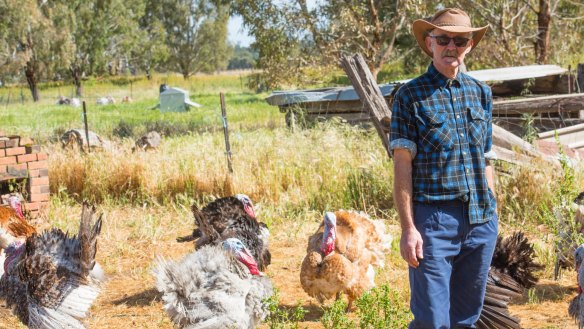
Turkey
It's hard to talk among turkeys, but Daryl Deutscher is used to the rabble. He grew up with the big birds on his family farm at Rupanyup, in Victoria's Wimmera, where they were used for weed control and to supplement farm income. Back then, they ate turkey every week.
"Mum used to cook it in a big cast-iron pot in the wood-fired stove," Deutscher says. "There'd be lard or dripping in the bottom, and bread and parsley stuffing on top of the breast – never inside the turkey – to protect the breast from drying out."
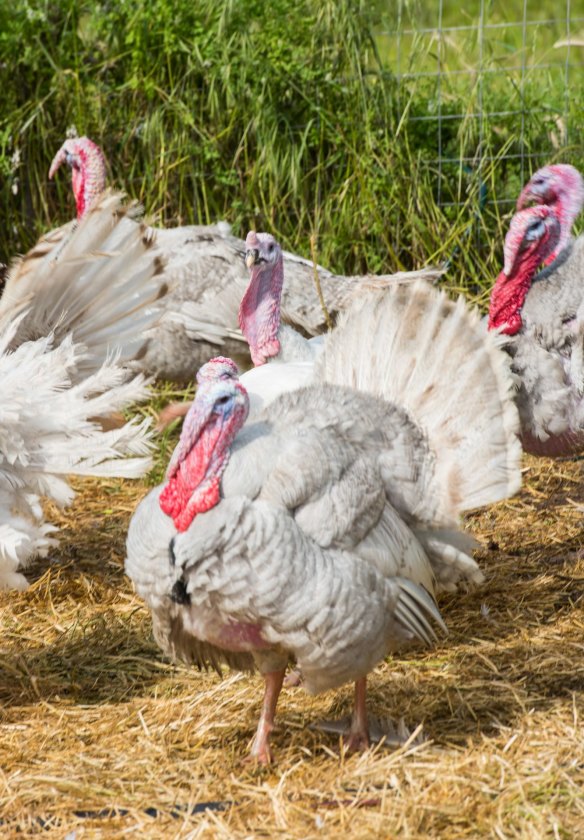
Deutscher moved onto his own farm in the little town of Dadswells Bridge near the Grampians in 1982. It was the perfect place to raise turkeys the old-fashioned way, with river red gums for shade, paddocks for grass and a poultry abattoir on site.
The problem was getting birds suitable for free-ranging. The old breeds were all but gone, replaced by birds bred in America to live in sheds. Deutscher scoured the country to find the last remaining old breeds, carrying names like Bourbon Red, Bronze and Slate. Today he raises these breeds from eggs, along with some modern birds.
Deutscher, like the handful of other small-scale free-range turkey farmers in Australia, produces birds that differ from supermarket options. They are raised on a variety of feeds that includes grass and insects. They are slaughtered on-site, reducing transport-induced stress. They are able to roam and run, which leads to darker, firmer flesh. They can carry a layer of fat just under the skin, which, as the turkey roasts, renders and bastes the flesh, making it juicy and tasty.
Unlike the big producers, Deutscher does not pump his birds with water and chemicals to keep them moist. "I'm the real deal," he says. For stockists, call 03 5359 5220.
Also excellent: In East Gippsland, Victoria, Leadoux Free Range Turkey processes on-farm; find them in butchers in eastern states. Pooginagoric Free Range Turkey Farm at Bordertown, South Australia, also processes on-farm and supplies butchers in Sydney and Melbourne. For stockists, call 08 8753 7213.
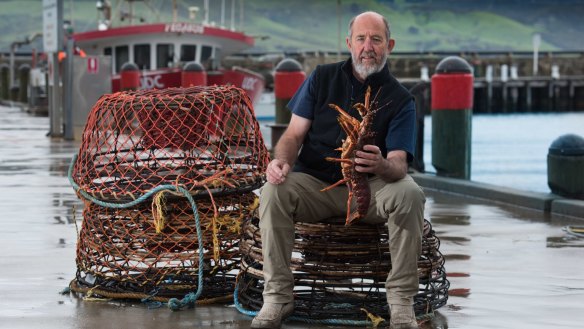
Rock lobster
Russell "Frosty" Frost is a warm bloke with a casual demeanour. He fishes for Southern rock lobster or "crayfish" as they still call them in Apollo Bay. This is a fishing town in south-west Victoria on a beautiful arc of golden sand backdropped by the steep green hills of the Otway Ranges. Frost first headed to sea when he was 13. Growing up in Port Melbourne, he joined famed fisherman Doug "Dugga" Beazley and fished for snapper, flathead and whiting in Port Phillip Bay. A keen surfer, he headed west but eventually returned east via Apollo Bay, where he found a new home. He worked on cray boats before buying his own, the Karlene Maree, one of the last boats built in the Apollo Bay yards.
Frost fishes the coastal waters from the Twelve Apostles to Cape Otway, and knows the underwater terrain like farmers know their paddocks. He has a mental map of the reefs, rocks, and underwater ravines. He knows where the lobsters will be and, with the help of GPS, can drop a cray pot and return the next day to haul up the catch. Pots are actually round traps, made of wire and bent cane, baited with fish with a one-way funnel – the lobsters crawl in for a feed but can't get out. They are kept in tanks in the Apollo Bay Fisherman's Co-operative. "These are for Dan Hunter at Brae," says Frost, proudly, referring to the award-winning restaurant on the other side of the Otway Ranges.
Southern rock lobsters caught in Bass Strait are highly sought after, fetching around $110 a kilogram, with much of the catch exported to Asia. "When I started in the '70s we were selling them for $2 a kilo," Frost says. Southern rock lobsters have firm white flesh that is rich, sweet and delicious. To prepare, Frost recommends putting a live lobster to sleep in the freezer, then cutting it in half lengthways with a sharp knife, dotting it with butter, and cooking it under a hot grill. apollobayfishcoop.com.au
Also excellent: Much cheaper than lobster but equally delicious are Moreton Bay bugs. Freshwater crayfish, aka yabbies, are sweet and good value. Ask for them at South Melbourne and Queen Victoria markets or Sydney Fish Market.
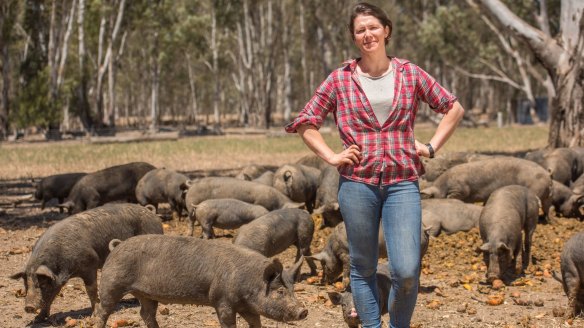
Pork
The pork Lauren Mathers grows is superb. It's sweet, succulent and perfectly layered with rich fat. The skin crackles easily, and the juices make brilliant gravy. Her hams are big, plump, elegantly smoky and full of the flavour of her neighbour's oranges and her aunt's bay leaves that steep in the brine. She and her husband, Lachlan, raise the old English Berkshire breed on their Bundarra farm on the banks of the Murray River at Barham, in New South Wales. They started growing pigs about 10 years ago. Along with her parents, who have a neighbouring farm, the Mathers raise about 600 pigs a year for slaughter. The pigs live on the pasture under river red gums, "but the dry is stymying our efforts to feed them a lot of grass," Mathers says.
Life in the country can be hard. But Mathers is a problem-solver. When the local abattoir closed, she found herself having to truck her pigs hundreds of kilometres for slaughter. Now she is teaming with the local council to build a community abattoir. She has a vision for small growers from along the Murray to be able to process and butcher their animals locally and sell direct to customers.
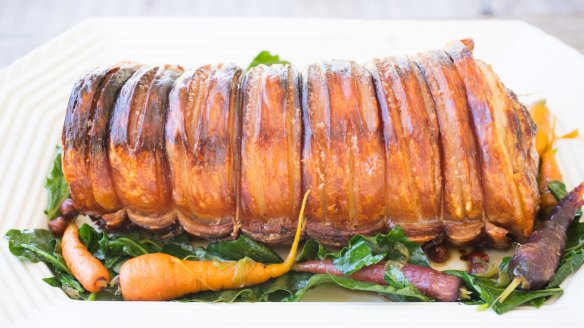
Mathers once had a problem with finding butchers to cut her meat to her exacting specifications, so she learned the trade and built herself a farm-gate butchery among the red gums. Here she and her small team make bacon, terrine, fricandeaux and her award-winning hams. This month she plans to move into her purpose-built butchery in the heart of Barham and concentrate on making and selling her smallgoods and charcuterie.
"To tell you the truth, hams are going to be hard to get hold of this year," she says. "I have 100 left." Mathers recommends people also consider porchetta (rolled pork belly, pictured above); she stuffs hers with rosemary, garlic, cranberries and lemon rind. "Every farmer is doing it tough, really tough, this year," she says. "So, make sure you're buying your Christmas dinner from Australian farmers." bundarraberkshires.com.au
Also excellent: Extraordinary Pork is processed on-site on a regenerative farm near Dubbo; their hams are at Feather and Bone. McIvor Farm near Heathcote, Victoria, make smallgoods from their truly excellent Berkshire pork.
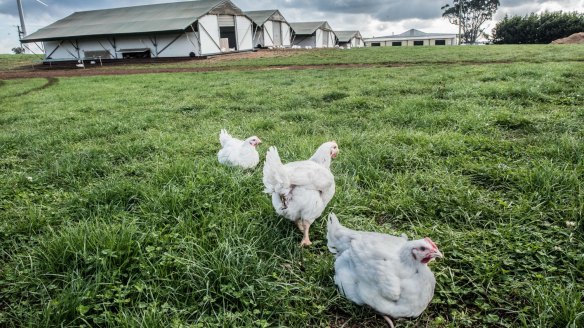
Chicken
It's a brisk Tasmanian morning. Poultry farmer Robert Nichols is out on his Sassafras farm with his chickens, who are clucking about the lush grass. Nichols' flock are behaving like chooks should, scratching, foraging, bathing in dirt. A third-generation poultry farmer with three decades of experience, Nichols has spent years working on farming an affordable yet truly free-range bird.
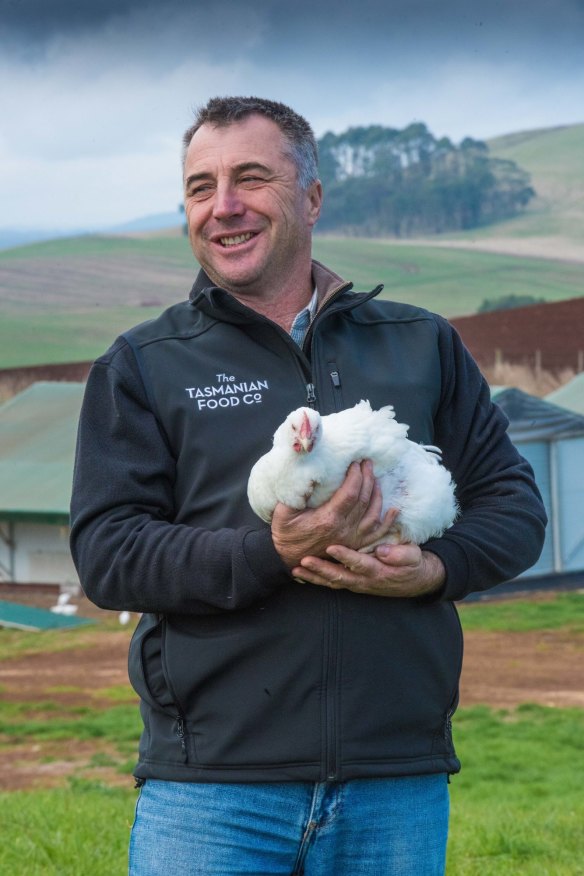
"There was no government [legislation] for 'free-range' table birds," he says. "There could be 50,000 birds in a shed with a pop hole [small door] they seldom stepped through, and they could be labelled free-range."
After a lifetime observing chicken behaviour, Nichols designed a style of shed with lift-up doors and shady awnings. The sheds are mobile, so the flocks of 850 birds can easily shift to greener pastures. The chickens are fed pellets but also eat a lot of wild insects and grass, the beta carotene in the grass giving the fat a lovely yellow tinge.
Nichols also wanted to grow a better-tasting bird, so his chickens are processed at 52 days compared with 42 days for most supermarket birds – so have darker and firmer meat. Nichols' chickens are processed using warm water, not hot, and the birds are blast chilled, not dunked in a chlorine bath. This means their skin crisps with a glossy golden finish and tastes just of chook. nicholspoultry.com.au
Also excellent: Russell Mickle grows chickens, ducks, poussin and quail at Milawa Free Range Poultry in Victoria. Call 0428 570 492. Sommerlad chickens are costly but taste superb; try Milking Yard Farm in Melbourne, or Feather and Bone in Sydney.
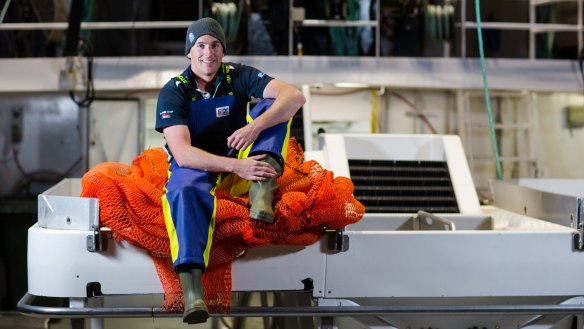
Prawns
It's mid-afternoon, and the South Australian sun is bathing the decks of prawn boat Lunar Sea. There's a gentle swell on the Spencer Gulf, and the wheat silos of Wallaroo rise and fall on the horizon. Skipper Ashley Lukin has just started his day of hauling in prawns. Spencer Gulf King Prawns are known by many seafood aficionados as the best in the land. The cool, clear waters and careful handling give them a deep, sweet flavour and rich, firm flesh.
Prawn season runs from November to December and then March to June, with only 55 nights to bring in their quota. Working under moonlight the crew hauls in the prawns, sorts them, packs them into boxes and snap-freezes them to around minus 40C, all within 30 minutes. Tomorrow morning they'll motor back to Port Lincoln to offload the catch. Closer to Christmas, they'll berth at Wallaroo and drop off the catch to go to market. "Prices are best before Christmas. There's no point landing prawns after that until later in the year," Lukin says.
Lukin learned to cook at 13 when he first went to sea in the school holidays. "I cook prawns in a buzara, a Croatian seafood stew with garlic, tomatoes and white wine. My crew says it's hard work, but we eat like kings." spencergulfkingprawns.com.au
Also excellent: If it's size you're after, pre-order a box of extra-large Mooloolaba Prawns caught off the Sunshine Coast. In Victoria, ask for Tacoma prawns also from Spencer Gulf. Summer has a brief season for sweet Gippsland school prawns sold in Sydney and Melbourne markets.
